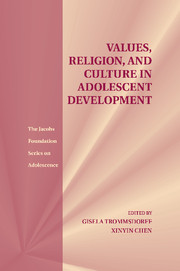Book contents
- Values, Religion, and Culture in Adolescent Development
- Series page
- Values, Religion, and Culture in Adolescent Development
- Copyright page
- Dedication
- Contents
- Contributors
- Preface
- Acknowledgments
- Part One Theoretical Perspectives on Values, Religion, and Adolescent Development in Cultural Context
- Part Two Universal and Culture-specific Functions of Adolescent Values and Religion
- Part Three Impact of Values and Religion on Adolescent Adjustment in Times of Social Change
- Part Four Socialization Processes of Values and Religion in Adolescent Development
- Index
Part Two - Universal and Culture-specific Functions of Adolescent Values and Religion
Published online by Cambridge University Press: 05 September 2012
- Values, Religion, and Culture in Adolescent Development
- Series page
- Values, Religion, and Culture in Adolescent Development
- Copyright page
- Dedication
- Contents
- Contributors
- Preface
- Acknowledgments
- Part One Theoretical Perspectives on Values, Religion, and Adolescent Development in Cultural Context
- Part Two Universal and Culture-specific Functions of Adolescent Values and Religion
- Part Three Impact of Values and Religion on Adolescent Adjustment in Times of Social Change
- Part Four Socialization Processes of Values and Religion in Adolescent Development
- Index
Summary
This chapter briefly reviews the nature of ten basic values recognized in cultures around the world that influence attitudes and behavior in all societies. Using data on Protestant, Roman Catholic, Muslim, Eastern Orthodox, Jewish, and no religion samples of adolescents and adults from representative national samples from 30 countries, it addresses questions important for understanding the development of adolescents’ values and the relations of their values to religion. Research reveals that, by mid-adolescence, the dynamic structure of conflicts and compatibilities that gives coherence to adult value systems has already developed. Moreover, this holds in all six religion groups. Thus, the structure of relations among the ten basic values is largely a function of universal developmental processes rather than of socialization into particular religions. Adolescents understand and organize the ten basic values in ways similar to adults, but their value priorities differ from those of adults. Adolescents accord substantially less importance than adults do to all of the other-oriented values. They are less concerned than adults with promoting the welfare of members of their in-group (benevolence) and of the wider society (universalism) and with avoiding change or uncertainty (security, conformity, and tradition). On the other hand, adolescents give higher priority than adults to self-enhancing values (achievement and power) and to values that encourage the pursuit of excitement (stimulation) and pleasure (hedonism). Values that emphasize autonomy (self-direction) peak in late-adolescence and remain very important until the mid-30s before declining thereafter. The chapter discusses aspects of development and socialization that can account for these near universal trends and for small changes in value priorities that occur between mid- and late-adolescence. Do more and less religious adolescents differ in their value priorities? The chapter reports that, strikingly, very similar patterns emerge regardless of religion. Religiosity relates most positively to tradition values, positively to conformity values, negatively to self-direction, stimulation, and power values, and most negatively to hedonism and stimulation values. These findings suggest that differences in religiosity among adolescents are largely a product of adolescents’ choices about how religious they should be based on their individual value priorities. Socialization and teaching within particular religions plays a smaller role. We consider values and religiosity to be important because we assume that they influence significant attitudes and behavior. The chapter examines how adolescents’ basic values and/or their religiosity influence the centrality of family in their lives, the importance of helping needy people, and the importance of always obeying the law. Analyses reveal that adolescents’ individual value priorities have a much stronger influence on these attitudes than their degree of religiosity does. Finally, the chapter examines processes of value acquisition that affect parent–adolescent value similarity, using data from Israeli adolescents. It notes that what may appear to be parental value transmission actually involves active value acquisition by adolescents. Exposure to parents’ social circles and parental warmth and responsiveness increase value similarity by contributing to accurate perception of parents’ socialization values and/or acceptance of these values, whereas autocratic and indifferent parenting and love withdrawal undermine similarity in Western cultures.
- Type
- Chapter
- Information
- Values, Religion, and Culture in Adolescent Development , pp. 95 - 208Publisher: Cambridge University PressPrint publication year: 2012

